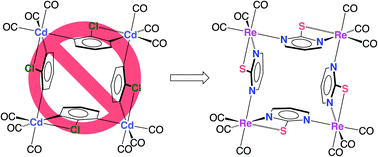Rhenium versus cadmium: an alternative structure for a thermally stable cadmium carbonyl compound†
Abstract
An alternative description is provided for the previously reported novel tetranuclear cadmium carbonyl compound, [Cd(CO)3(C6H3Cl)]4. Specifically, consideration of single crystal X-ray diffraction data indicates that the compound is better formulated as the rhenium compound, [Re(CO)3(C4N2H3S)]4. Furthermore, density functional theory calculations predict that, if it were to exist, [Cd(CO)3(C6H3Cl)]4 would have a very different structure to that reported. While it is well known that X-ray diffraction may not reliably distinguish between atoms of similar atomic number (e.g. N/C and Cl/S), it is not generally recognized that two atoms with very different atomic numbers could be misassigned. The misidentification of two elements as diverse as Re and Cd (ΔZ = 27) is unexpected and serves as an important caveat for structure determinations.

- This article is part of the themed collection: Most popular 2019-2020 inorganic, main group and crystal engineering chemistry articles


 Please wait while we load your content...
Please wait while we load your content...